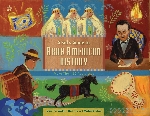Arab American history guide world-expanding for kids

Everybody has to come from somewhere in the world.
Your best friend, for instance his family came from Mexico. A classmate of yours had ancestors from Africa, and another classmate’s Mom was born in China. Maybe your own grandparents immigrated from Germany , India , or Israel.
So what do Salma Hayek, Jerry Seinfeld, Steve Jobs, Ralph Nader, Casey Kasem, Hoda Kotb, Doug Flutie, Donna Shalala, and Paula Abdul all have in common? Find out the answer and more in "A Kid’s Guide to Arab American History" by Yvonne Wakim Dennis and Maha Addasi.
So what do you know about Arab Americans? Chances are that what you "know" is wrong because of stereotypes and myths. Arab Americans, for instance, don’t necessarily come from "oil-rich countries." They don’t ride camels, they’re not all Muslim, and they’re not all terrorists.
So what are Arab Americans? Well, they’re Americans, first of all, and they look and act just like everybody else in the U.S., but they may have roots in any of the 22 countries that are officially considered Arab. That includes Egypt, Saudi Arabia, Somalia, Syria, and Libya. If you look at a map or globe, you’ll see that Arab countries are located on two different continents.
Many people of Arab descent arrived here during a wave of immigration that happened between 1890 and 1920, although historians believe that the first Arab Americans came to North America about 3,000 years ago; long before Columbus made his voyage here. Today, Census records show Arab Americans in all 50 states, although the vast majority of them have settled in larger cities.
And you should be very glad they did: Arab Americans have contributed their expertise to U.S. politics, science, and literature. They’ve worked on behalf of Civil Rights and against drunk driving. They brought yummy dishes to this country, and beautiful art. You may know an Arab American doctor, lawyer, or fashion designer.
And even if you don’t, there’s something for you in this book. Learn about Arab customs and dances. Make musical instruments, jewelry, or traditional clothing. With this book, you’ll learn many words in several languages, including counting words; recipes you can make; some great new fables to share; new comic book heroes to enjoy; games to play; and even a few new traditions!
Is your child looking to stretch his horizons? Is she curious about other cultures? Then grab "A Kid’s Guide to Arab American History" because there’s a lot to learn.
Arab American history, as it turns out, is a pretty big subject, and authors Yvonne Wakim Dennis and Maha Addasi do a good job touching upon each culture at least a little bit. The problem is that much of the information felt to me to be awfully similar, the projects were a lot alike, and even the games lacked variety.
That may not be an issue for your child, however, because this book is not, after all, for grown-ups. Your 8-to-12-year-old may like it anyhow because "A Kid’s Guide to Arab American History" could expand his world.
"A Kid’s Guide to Arab American History" by Yvonne Wakim Dennis and Maha Addasi, c.2013, Chicago Review Press, $16.95 / $18.95 Canada, 204 pages